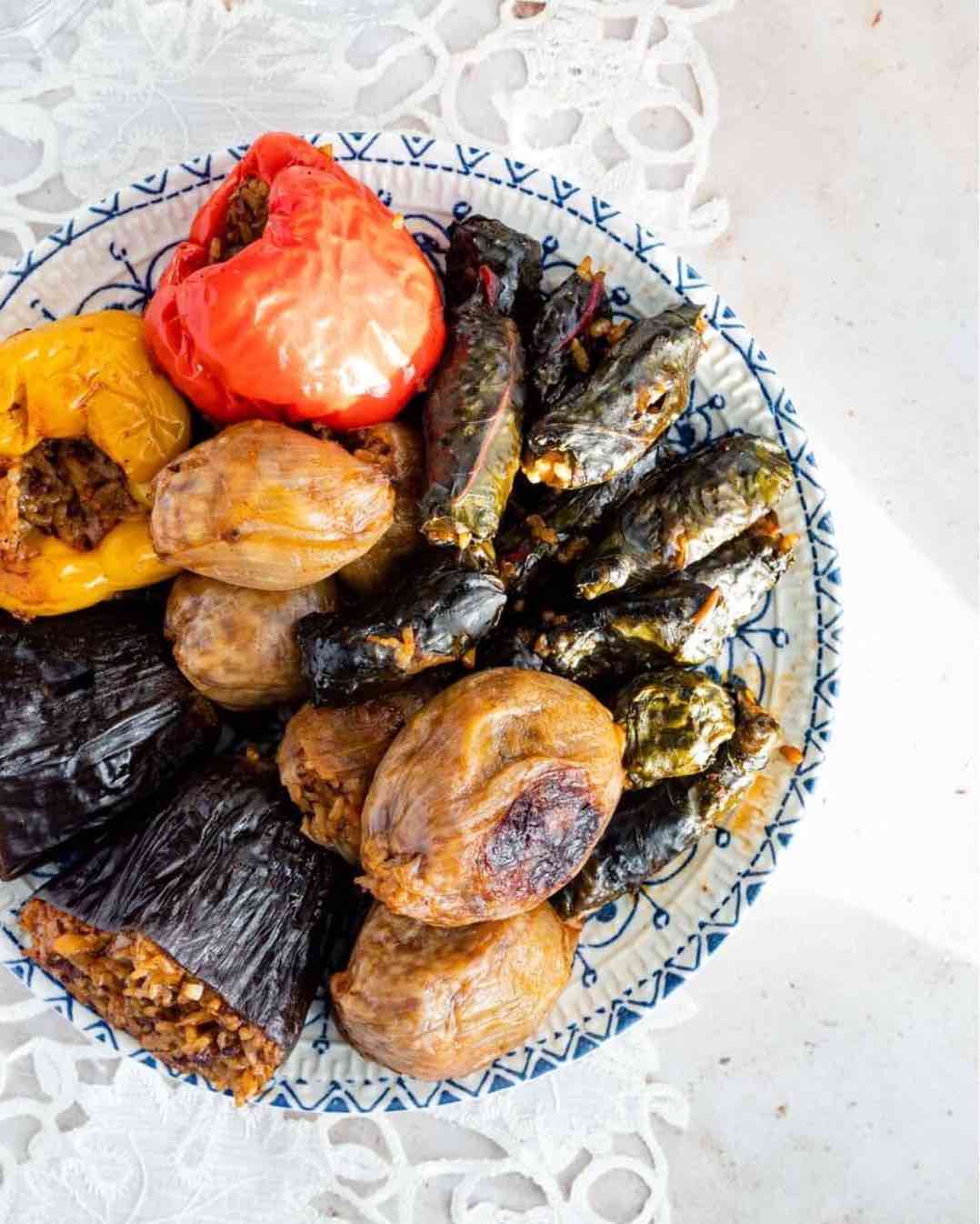A particular favourite from the Ctesiphon region, dolma is famous throughout the middle east. Vegetables, stuffed with seasoned rice and vegetables and cooked in a spicy tomato broth. The dish has many variations and has been part of Middle Eastern cuisine for centuries – it’s found in Arabic cookbooks pre-ottoman era. Serves 6-8. Can be halved.
You can make Dolma with all or a combination of these vegetables, depending on availability and seasons: Eggplant (avoid the very large variety), Green zucchini, cut into 3 pieces, Onions – a must to use every time, Bell peppers (capsicums), Tomato (another essential).
You can make Dolma with all or a combination of these vegetables, depending on availability and seasons: Eggplant (avoid the very large variety), Green zucchini, cut into 3 pieces, Onions – a must to use every time, Bell peppers (capsicums), Tomato (another essential).
Dolma (Middle Eastern Stuffed Vegetables
|
INGREDIENTS:
For the stuffing mixture:
|
METHOD:
For the stuffing mixture:
Notes
For the stuffing mixture:
- Finely dice the onions and red peppers and mince the garlic
- Wash the rice well until the water runs clear and drain
- Mix together the all the ingredients for the stuffing: meat, rice, vegetables, garlic, tomato paste, pomegranate molasses, oil, salt and pepper. Use your hands and mix until very well combined. Set aside.
- For the eggplant: cut the eggplant into 2 pieces. Using a sharp paring knife, place the eggplant on a cutting board sideways with your hand on top, then core around the inside of the eggplant until you reach the other side or until you can use your fingers to scoop out the flesh.
- For the zucchini: start by scraping away the skin using a sharp knife, then trim the ends. Cut the zucchini into 3 pieces then core using the same method as the eggplant
- For the pepper: carefully cut around the stem and remove it, then using your fingers, remove the inner seeds and any white parts. Use a small knife if necessary.
- For the onion: first peel, then dig around the end where the root was and carve it out. Make a long cut lengthwise all the way to the centre - do not cut past the centre. Microwave the onions for 1 minute to soften the layers slightly (you can also boil for a minute). Wait for it to cool, then carefully dislodge the layers and pop them out.
- For the Swiss chard: before stuffing, wash the leaves well and then submerge in a bowl of boiling water for 3 seconds. Remove them and place them on a tray. This helps wilt the leaves and makes them more pliable for stuffing. Cut off the thick stems and cut the leaf into 2 or 3 pieces, depending on the size.
- For the grape leaves: grape leaves come in jars submerged in water (don't use the frozen ones). Generally, the leaves are salted, so before using them, soak them in water for at least an hour to get rid of excess salt, then wash them a few times and drain. You can squeeze them carefully to get rid of excess water.
- Add ¼ olive oil to the bottom of a large pot, then line the bottom with the flesh of the eggplant and zucchini that you carved out.
- Stuff the "rigid" vegetables first: eggplant, zucchini and pepper. Fill them ¾ of the way because the rice will expand during cooking. Stack the eggplant and zucchini together so they remain in place.
- Stuff the onions and squeeze them into all the empty spots.
- Finally stuff the Swiss chard and grape leaves and use them to fill in all the cervices and tightly pack everything in. To roll the leaves, place a small amount in the middle of the leaf. Fold the sides over, then roll the leaf keeping a tight grip. Place in the pot seam side down.
- Prepare the cooking liquid by mixing all the ingredients together well until the tomato paste has dissolved (you can use hot water to help this).
- Pour the liquid into the pot ensuring it goes all the way up to halfway through the top layer. Don't completely submerge the top layer.
- Place a flat plate on top of the pot to keep everything in place.
- Cover the pot and bring to a boil on high heat for 15 minutes. Taste and adjust the seasoning of the liquid (add more salt or acid if you need to).
- After 15 minutes, remove the plate and give the pot a jiggle to help the water travel downwards. Decrease the heat to medium and allow it to cook for another 15 minutes.
- Finally, decrease the heat to low and cook for 1 hour. Taste it after the hour and make sure all the vegetables are really soft.
- Allow the dolma to stand for 10-15 minutes, then flip it into a round metal tray with raised sides. If you don't have a round platter or tray, you can use a spoon to spoon the dolma into a platter.
Notes
- If you can't find pomegranate molasses, which is used in the stuffing mixture and the cooking liquid, you can replace it with lemon juice and a bit of sugar. Use the juice of 2 lemons and about 2 teaspoons of sugar for every ¼ cup pomegranate molasses
- Citric acid is readily available, but if you don't have it, add some lemon juice to the cooking liquid in place of it. Use the juice of 2-3 lemons
- You can replace the Swiss chard with grape leaves or vice versa if you can't find one of them
- If you have leftover stuffing, use it to make a rice pilaf
- If you find you need more cooking liquid as the dolma cooks, you can just use a splash of water
- Use a wide non-stick pot for best results
- You can prepare the vegetables the day prior and store them in the fridge.

